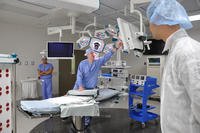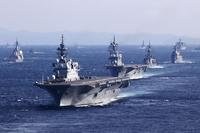The U.S. Navy successfully conducted a first test-flight of its MQ-4C Triton aircraft, a wide-spanning 47-foot long surveillance drone equipped with high-tech, next-generation sensors able to conduct surveillance, reconnaissance and communications-relay missions over thousands of miles ocean, service officials said.
During the 80-minute flight in restricted airspace in Palmdale, Calif., the MQ-4C Triton unmanned aircraft, controlled by ground-based Navy and Northrop Grumman personnel, reached 20,000 feet, according to a Navy statement.
%embed1%
“This flight represents a significant milestone for the Triton team,” Rear Adm. Mat Winter, who leads the Program Executive Office for Unmanned Aviation and Strike Weapons at Naval Air Systems Command, Patuxent River, Md., said in a written statement provided by the Navy. “The work they have done and will continue to do is critical to the future of naval aviation, particularly to our maritime patrol and reconnaissance community.”
The MQ-4C Triton UAS will be based at five locations around the globe. Triton operators will disseminate data in real-time to fleet units to support surface warfare, intelligence operations, strike warfare and search and rescue
“Our goal is to mature the Triton UAS before supporting the Navy’s maritime ISR mission,” said Capt. Jim Hoke, program manager for the Persistent Maritime UAS office (PMA-262), which oversees the Triton program. “The data we collect the next few years is essential to certify the system for operational use.”
The aircraft, which boasts a 130-foot wingspan and can reach altitudes of 60,000 feet, is engineered as a long-endurance surveillance platform, meaning it can stay in the air as long at 30 hours on a single mission, according to Navy figures.
The Triton’s first planned flight was part of an ongoing System Development and Demonstration (SDD) phase, in place since the Navy awarded Northrop Grumman a $1.16 billion deal to develop the aircraft in 2008, an industry source indicated.
The 89-month SDD phase, which includes initiatives to develop, test and refine the engineering of the air vehicle and integrate the sensor payload, is an acquisition phase aimed at refining requirements for the system and maturing its technologies prior to formal production, an industry source explained.
Thus far, two MQ-4C Triton’s have been built and a third is under construction at a Northrop facility in Moss Point, Miss., an industry source said. The Navy plans to build additional aircraft and move toward an Initial Operational Test and Evaluation by 2015, a move which assesses the operational and technological readiness of the system prior to formal production.
The Triton UAS, part of the Navy’s Broad Area Maritime Surveillance UAS developmental program, is a specially engineered maritime variant of the Air Force’s RQ-4B Global Hawk platform, Navy officials explained.
“The modifications include anti/de-ice, bird strike and lightning protection to meet planned mission profiles and a due regard radar for safe separation from other aircraft,” Hoke added.
The anti/de-ice and lighting protection technologies, which include a reinforced fuselage and wing, are being engineered into the MQ-4C Triton as part of the maritime requirements for its range of anticipated mission sets, Navy and industry officials said.
“The Navy’s maritime variant is engineered to operate beneath the weather and have the ability to quickly be re-tasked as mission requirements dictate,” a Navy official said.
Since identifying ships, watercraft and coastal items are part of the Triton’s mission set, the aircraft is being engineered to ascend and descend to make identification of targets, an industry source added.
“The Global Hawk was meant for high-altitude missions over land. Triton contains upgrades and changes to make it capable of this kind of maritime mission. The difference with Triton is you are going over ocean. The Triton has a 360-degree capability with all of its sensors. The Naval domain is every which way,” he said.
The Triton is equipped with Automatic Identification Systems as part of its sensor payload, giving the aircraft an ability to track ship movements on the ocean by identifying their transponders.
Through a process referred to as manned/unmanned teaming, the Triton is engineered to work in tandem with manned surveillance aircraft such as the P8-A, or Poseidon, according to a Navy factsheet on the program.
In fact, the Triton’s next-generation radar, called the Multi-Function Active Sensor (MFAS), is a 360-degree radar capability optimized to provide the identification of surface ships over vast areas covering thousands of miles, an industry source said.
The Triton's sensors also include a high-definition, Electro-Optical/Infra-Red camera and a communications relay device so that it can function as a line-of-sight “node” connecting Naval forces dispersed over a large area.
MFAS is engineered with a multi-mode capability, meaning it can operate in maritime-surface-search (MSS) mode for tracking maritime targets and also in inverse-synthetic aperture mode for classifying ships, an industry source explained.
The MQ-4C can reach airspeeds up to 310 knots and is able to perform persistent surveillance missions over areas up to 2,000 nautical miles, a Navy factsheet confirmed.









